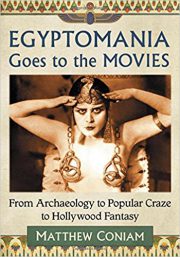When in 1922 British archaeologist Howard Carter opened the sealed tomb of an Egyptian ruler – a comparatively unimportant king who reigned for nine years only – named Tutankhamen, Carter started a huge fad that lasts until today. Since what followed was an unequaled run that spread all over the Western world and started “Tutmania.” 
Before that, “Egyptomania,” the fascination with Egyptian design and architecture had already been a common style in Western aesthetics for some time. Very soon after Carter’s discovery of Tutankhamen’s mummy, the corpse was simply nicknamed “King Tut” and his name and picture were “… used to sell everything from soap to cigars to pencils to canned food.”
Popular culture was massively enriched and enchanted by the Carter excavation and what followed was a lasting effect on fashion, design (as it gave new impulses to Art Deco for example) and naturally media productions, particularly movies.
The new, well-liked interest in all aspects of Ancient Egypt from the early 1930s onward created “… a receptacle for every stray aspect of weirdness and eeriness and wild speculation the story engendered in the popular press, comic books and short story anthologies.”
While an afterlife, communication with the dead and preparations for a resurrection of the deceased soul into its own body were robust and therefore necessary beliefs – hence the act of creating mummies and embalming the body – for the people of Ancient Egypt, it hit Western civilization as a collection of impossibilities and atrocities; at the same time, a morbid strong fascination with it took over.
As Hollywood finally invented a genre that was later to be called horror films, it did so with the help from Tutmania as actor Boris Karloff starred in Universal’s The Mummy in 1932 (the five previous American films by that name were unimportant productions compared to his one). Karloff’s character “Imhotep” also represents the archetype of the violent and murdering mummy (who initially tries to restore some kind of ancient order). In three of the four movie sequels to come between 1940 and 1944 Lon Chaney, jr. plays the mummy “Kharis,” that actually is a copy of Karloff’s Imhotep.
Author Coniam tells a very detailed story of the “mummy boom,” starting with the earliest appearance of a mummy in (Western) popular culture in a novel from 1840 and the fascination that hit Europe and later on the US. This was always connected with fantasies of everlasting longing, hatred, romantic fantasies about eternal love stories, curses and a strong desire for violence and murder.
Coniam collected numerous stories about their place in Western history, including uses of the resource “mummy” (ground mummy matter that was used as a medication in the 17th Cent.), American imports of tons of mummies for paper production from their bandages, a general longing for mythical powers and practices to achieve everlasting life, combined with never-ending fantasies of a spiritual as well as of sexual nature, which were to define Egyptomania.
“‘Mummy’ also served, it has been claimed in some contemporary sources, as a condiment in eighteenth century banquets, and in the nineteenth century mummies burned as fuel on steam engines and in factories. Small wonder that they want to rise from the dead and kill us.”
More chapters throughout the book reveal the use and meaning of ancient curses (in the movies) protecting Egyptian tombs, and various ways of “mummy impersonation” and human sacrifice in almost 80 years of horror pictures.
The entire story of Egyptomania may be better documented in other publications. Coniam, however, has written a complete history of the history of Egyptomania and the mummy craze at the movies, how it first hit Hollywood and the way the British Hammer studio continued the idea. The book comes with a 17-page filmography of Egyptomania and mummy movies.
So far, the title is a recommended and most entertaining resource for any serious fan of mummy films and horror pictures connected with Ancient Egypt.
Coniam is neither archaeologist nor a student of Egyptology, but a writer on media and film from Bath, England.
Review by Dr. A. Ebert © 2017
Matthew Coniam. Egyptomania Goes to the Movies: From Archaeology to Popular Craze to Hollywood Fantasy. McFarland, 2017, 200 p.
